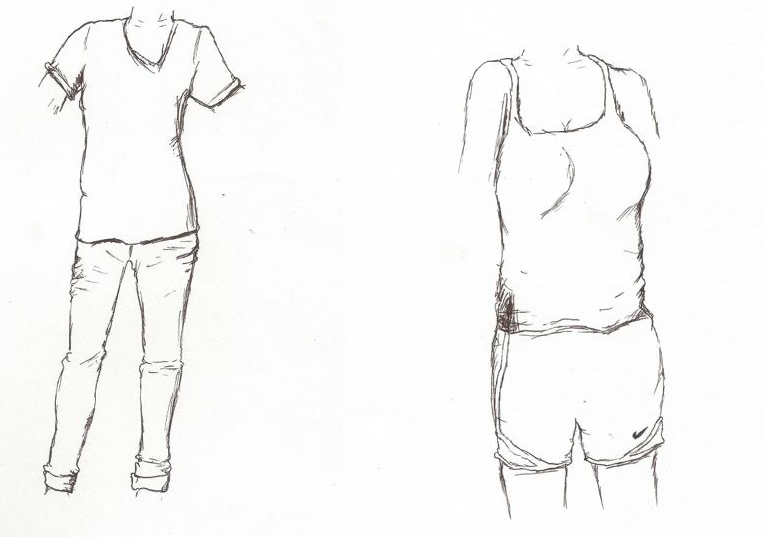Based on the 2015-16 dress code, the student to the left is in dress code. The student has their shoulders covered and is wearing jeans. The student to the right is out of dress code. Her shoulders are exposed and her shorts are not fingertip length. Cartoon by Phineas Alexander
By ANEESA CONINE-NAKANO – Digital Managing Editor
When students returned to school on Aug. 11, the Clarke Central High School administration held class meetings to discuss expectations for the upcoming school year, including dress code. Assistant Principal Sheila Dunham discusses the dress code, its effect on students and how teachers and administration are going to enforce it.
Click to view the CCHS Dress Code.
Aneesa Conine-Nakano: How has the implementation of the dress code been different than last year?
Assistant Principal Sheila Dunham: It is pretty similar because we are going around to classrooms in the mornings (like we did last year) when we are able to, when we don’t have conflicting meetings. We did that last year, as well, but we are being more consistent with it. Consistency is important.
ACN: What is the plan to keep the dress code enforced all year past the first couple months of school?
SD: We are keeping a record of who is being sent to ISS for dress code violation and the date they got sent, so if it does get referred to an administrator at least we will know the history of it. And when I talk to a student, I document it in our software. This is our software. And I can show you girls if you want me to. On any student, if you go in and make a phone call, or talk to a parent, you can go in and make notes about the conversations so I could go in and say, ‘I talked to a student about dress code violation and then I could put ‘shorts too short, not meeting dress code’ or whatever it was or ‘undergarments showing’ or if it was a male student pants showing underwear. It is just enough so I have some idea about what it was instead of putting ‘dress code violation’. That way if the student gets sent to me again, I can see my note and see if it is the same type of thing coming up, if the student abides by the dress code but this one area they are having trouble with. That way the student and I can have a conversation about it.
ACN: From the administrator’s point of view, what is the purpose of the dress code?
SD: I think dressing a little different than you would dress on the weekend or in the evenings (is a good way to dress for school). I think it is just saying my focus is going to be on school, my focus is going to be on learning. But, I think the dress code is something that if students abide by it, that everybody’s going to look nice. I mean, nothing offensive. Nobody is going to offend anybody by showing a lot of themselves as far as being modest.
ACN: What are some complaints students have had so far?
SD: I won’t say I have had any complaints but I have had some students roll their eyes at me. Just like, ‘Quit harassing me,’ but not really any specific complaints. I think they (the ones who roll their eyes) would just rather no one say anything to them at all. But like I said, we try to keep it as low key as possible. We try to just make it about are you following the dress code or are you not. It’s not personal.
ACN: How has the dress code this year impacted students?
SD: For some people, it might help them stay more focused because if you have one student who is following the dress code and another student that is not following the dress code, you could have one student sitting there thinking, noticing that the other student is not following the dress code and that might be distracting. Obviously, students would better be able to answer the question. I don’t think student(s) like it when they feel a rule is not being applied consistently and fairly, across the board. I don’t think any student wants to feel singled out. And, so we try not to do that, we try not to make it personal.
Click here to view last year’s article on dress code.
More from Aneesa Conine-Nakano
